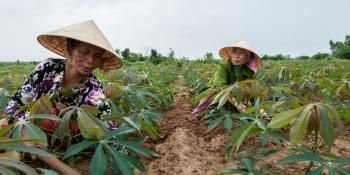Big Facts: Focus on East and Southeast Asia
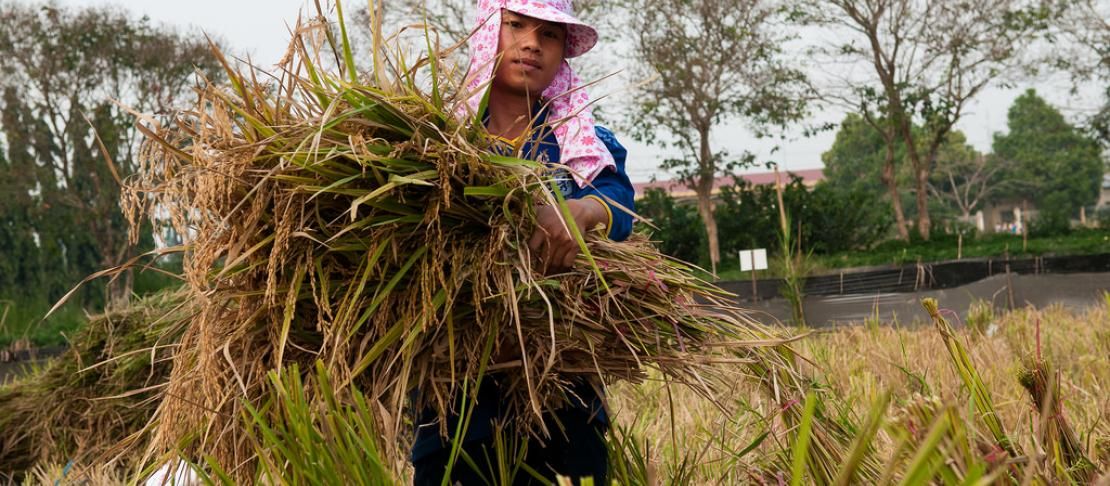
This story spotlights some of the Big Facts on East and Southeast Asia, and is part of a special blog series to complement the new Big Facts infographics website.
East and Southeast Asia is a big region, both in terms of geography and population. It is the most populous region in the world. It is also one of the most vulnerable. Because of the large geographical extent of the region, the impacts of climate change will vary significantly – from droughts in certain areas to floods in others and typhoons in others still.
Food Security
Despite significant progress in some countries, most notably China, undernourishment is still a large problem in this region. 232 million people are undernourished, about 11% of the population. Rice is the principle staple crop of Asia and any deterioration of rice production systems through climate change would seriously impair food security in this area (Wassman et al., 2009).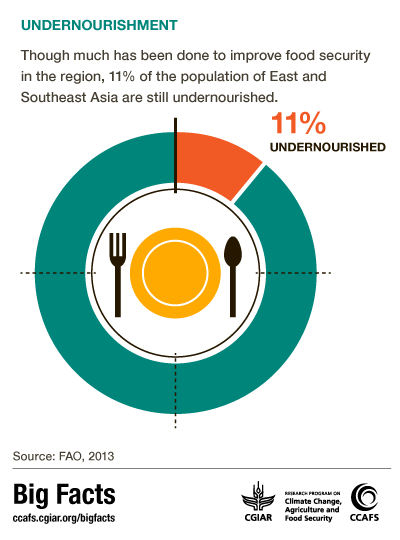
Impacts on People
In its 2007 Assessment Report, the Intergovernmental Panel on Climate Change (IPCC) found that the frequency of climate-induced diseases and heat stress in Central, East, South and Southeast Asia has increased with rising temperatures and rainfall variability (Cruz et al., 2007). While flooding in the deltas in Southeast Asia is part of the natural annual cycle in the region, the impacts of climate change are expected to create additional stresses (sea-level rise and land subsidence), increasing the vulnerability of human populations and undermining their livelihoods.
Weather-related events are frequent in this part of the world. When Yusuf and Francisco (2009) mapped hotspots for climate-related events and dominant hazards in Southeast Asia, they found that under climate change, Northwestern Vietnam will see an increase in droughts, while the Mekong region is at risk of sea level rise and floods. The small land area and often low elevation of small island states makes them particularly vulnerable to the rising sea levels expected under climate change and resulting impacts such as inundation, shoreline change, and saltwater intrusion into underground aquifers, which severely jeopardizes the livelihoods of the people living in these areas.
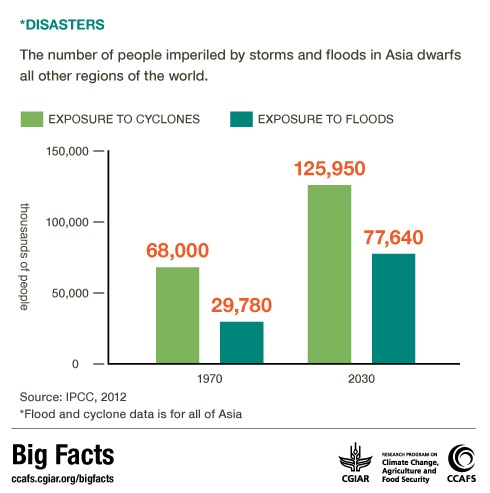
Impacts on crops
As described above, rice is an extremely important crop in this part of the world, and any climate change-related impacts on this crop could have potentially disastrous impacts. Bouman et al (2007) found that by 2025, 15-20 million hectares of irrigated rice will experience some degree of water scarcity. In fact, many rainfed rice-growing areas are already drought-prone under present climatic conditions. Drought stress is the largest constraint to rice production in rainfed systems, and in Asia, it affects 10 million hectares of upland rice and over 13 million hectares of lowland rice (Pandey et al. 2007).
This being said, rice exports from Thailand and Vietnam, the world’s largest rice-exporting countries, is expected to grow and account for more than 45% of world trade by 2020. Rice area and yields are projected to increase in Thailand, while per capita consumption declines slowly for both countries as incomes rise (OECD-FAO, 2013: 20).
More than 90% of the world’s aquaculture is produced in the Asia-Pacific region (FAO, 2008). The impact of climate change on aquaculture will be difficult to predict, as it will bring risks and opportunities, but it is likely that inland species with a low saline tolerance will have to be replaced with more appropriate species. Adaptation will be especially important in the aquaculture sector, as it could become an increasingly important source of animal protein under climate change as livestock and marine fisheries decline in many areas.
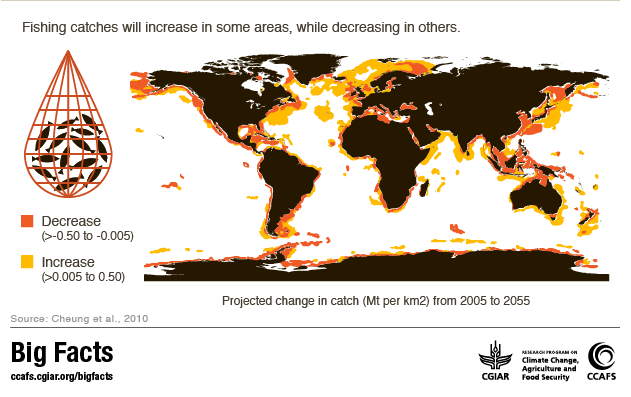
Adaptation
As the majority of the world’s rice crop is produced in this region, efforts to adapt this crop to climate change will be crucial. Traditional adaptation measures include improvement of irrigation systems and breeding of stress-tolerant rice varieties (Cruz et al., 2007). Newer approaches to ‘climate-proof’ rice production systems include Alternate Wetting and Drying (Bouman et al., 2007) and Sustainable Intensification of Rice Production (SIR). Benefits of SIR have already been seen in 40 countries, with increased production of both improved and local rice varieties. They include increase in yields, reduction in required seed and water savings, while also helping to reduce fertilizer and pesticides inputs. For more on this, see the adaptation page in the thematic section.
Mitigation
As rice farming releases significant amounts of methane, a potent greenhouse gas, limiting emissions from rice farming will be an important mitigation action in this region, for example by extending intermittent irrigation and adopting new varieties for paddy rice. Other practical mitigation approaches for farming in this region include enhancing the fertilizer-use efficiency or switching towards reduced or no-tillage farming.
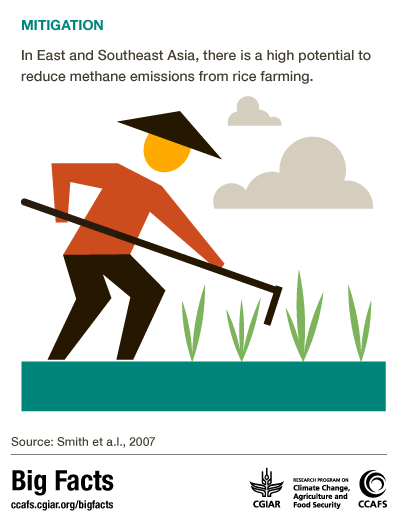
The impacts of climate change in East and Southeast Asia are not just about the impacts on rice farming. Future nutritional security will benefit from diversification in diets among the poor, so adaptation and sustainable intensification in other areas will be of high importance as well.
HAVE YOUR SAY
As in all areas of uncertainty, to find out what is really going to happen to this large area, you have to dig deeper. I suggest you start by having a look at some of the infographics found here. If that cannot satisfy your curiosity, CCAFS has published a number of issues on climate change impacts, some of these also deal with Asia. Finally, a number of resources are listed in the Big Facts project under each of the themes. To learn more, I invite you to consult these studies; they contain vast amounts of information. As always, if you have any comments or questions, feel free to post them below or write an email. Good luck exploring!
Now you can get all the Big Facts on the links between climate change, agriculture and food security at ccafs.cgiar.org/bigfacts2014. The new site features over 100 stunning infographics that illustrate the most up-to-date, thoroughly researched information on these topics.
Big Facts is also an open-access resource. You can download and share the graphics with your friends and colleagues and use them in your presentations and reports. Please do not hesitate to send us any suggestions for improvements, either by commenting below or sending us an email.
This story is part of a series focusing on the Big Facts on various topics and in different regions; join the conversation at ccafs.cgiar.org/blog and on twitter using #bigfacts



